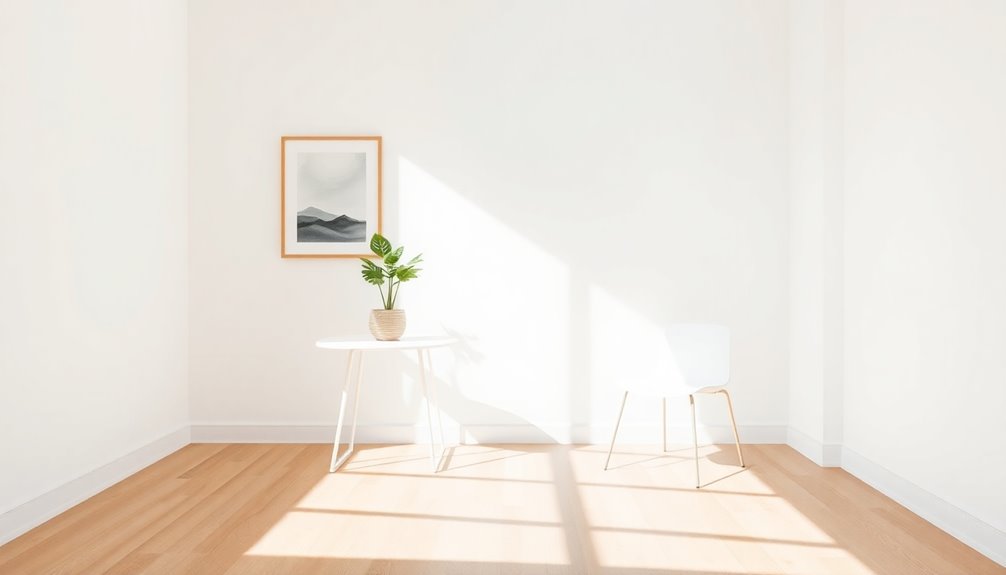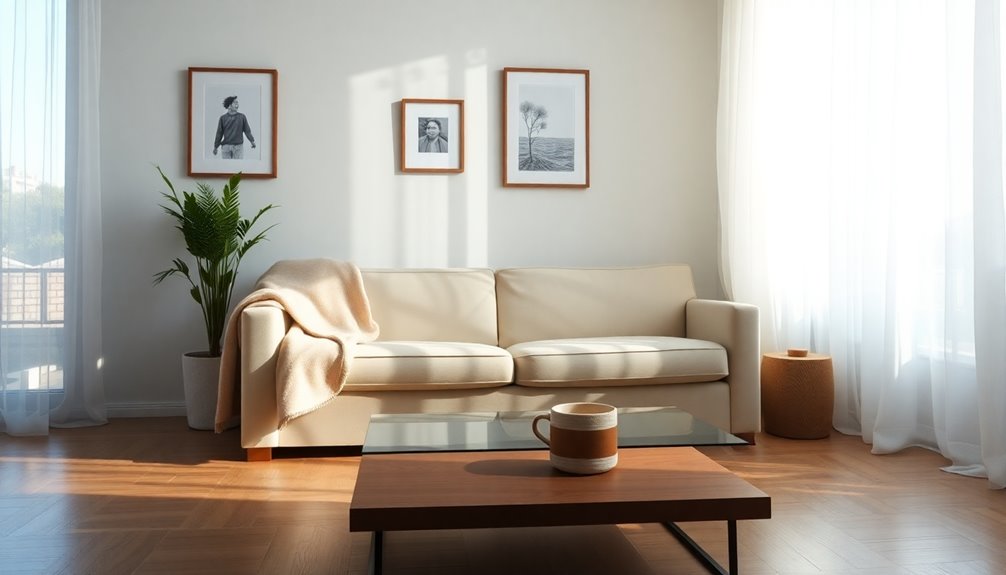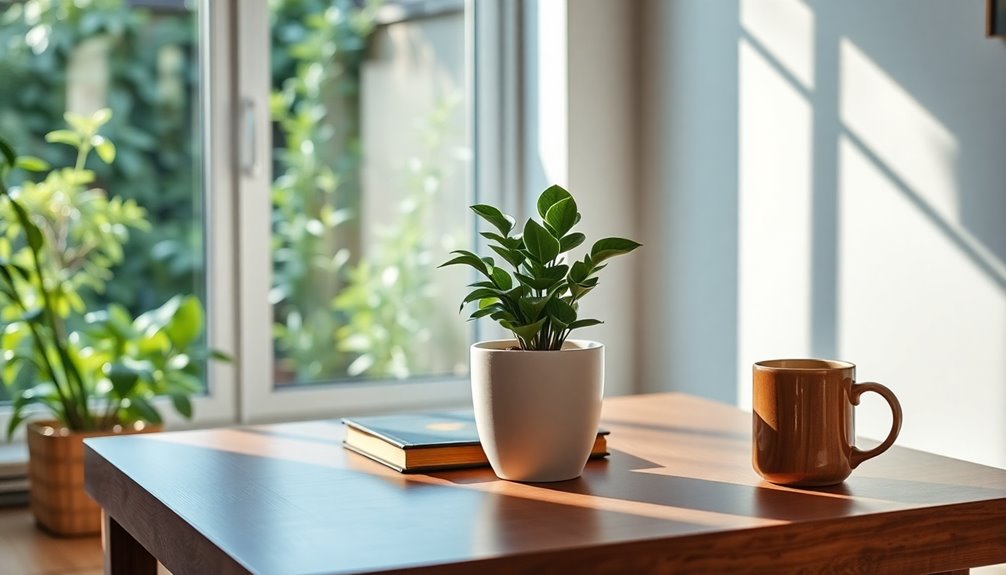To adopt a minimalist lifestyle in a cluttered world, start by evaluating your space and setting personal decluttering rules. Tackle each area of your home, eliminating duplicates and organizing belongings by category. Before buying, pause to judge necessity and value high-quality items. Cultivate gratitude for what you already own and involve your family in the process to simplify routines. By regularly reviewing your space and belongings, you can create clarity and purpose in your life. There's much more to explore!
Key Takeaways
- Assess your space regularly to identify clutter hotspots and establish personal minimalism rules that align with your values.
- Eliminate duplicate items and conduct seasonal reviews to maintain a streamlined and functional living space.
- Organize belongings by category and use effective storage solutions to enhance accessibility and reduce stress.
- Think critically before purchasing new items and prioritize high-quality, timeless pieces to avoid impulse buying.
- Involve family members in decluttering efforts to foster teamwork and create a collective commitment to a minimalist lifestyle.
Evaluate Your Space and Set Your Rules for Minimalism

As you commence your minimalist journey, start by taking a good look at your space and the items you own. Evaluate your space to pinpoint areas contributing to a cluttered environment.
Identify duplicate items and storage stressors that hinder your decluttering efforts. Establish personal rules for minimalism that reflect your lifestyle, needs, and values, ensuring a sustainable approach.
Prioritize decluttering efforts by focusing on the most cluttered areas, creating a more meaningful living space. Adopt an intentional mindset by starting small—tackle a drawer or shelf first. Implementing vertical storage solutions can further enhance your space optimization.
Regularly revisit your belongings to maintain this newfound clarity, ensuring everything you keep serves a purpose or brings joy to your life. Embrace minimalism and enjoy the freedom it brings!
Declutter Every Area of Your Home

To truly declutter your home, start by eliminating duplicate items lurking in different spaces; this alone can free up valuable room.
Make it a habit to conduct seasonal reviews of your closets, ensuring you keep only what you actually wear and need. Regular decluttering sessions can enhance focus and productivity by minimizing distractions in your living environment.
Eliminate Duplicate Items
While clutter can sneak into every corner of your home, eliminating duplicate items is a powerful first step toward a more minimalist lifestyle.
Start by identifying those extra sets of dishes or pairs of shoes that take up valuable space. Reducing clutter not only creates room but also eases the stress of organization.
Use a decluttering flowchart to help you decide which duplicates to keep, ensuring you maintain only one of each type of item.
Implement a seasonal review to consistently evaluate your belongings, keeping only essential items that bring joy. This process mirrors the holistic approach found in Sleep Solutions for New Parents, which emphasizes overall family well-being alongside practical strategies.
This process streamlines your belongings, enhances your mental space, and supports your minimalist lifestyle goals.
Embrace these minimalist lifestyle tips for a simpler, more organized home.
Seasonal Closet Reviews
Conducting seasonal closet reviews is essential for maintaining a minimalist lifestyle, ensuring you only keep items that truly serve you. Schedule these reviews at least twice a year to assess your clothing items.
During each review, categorize pieces into three groups: keep, donate, and discard. This simplifies the decision-making process and helps reduce clutter.
Implement the "one in, one out" rule; remove an old item every time you buy something new. Use a checklist to identify duplicates, out-of-season pieces, and items that no longer fit your lifestyle.
If you haven't worn something in the past year, consider donating or selling it. This approach keeps your closet manageable and aligned with your minimalist goals. Additionally, embracing intentional living can further enhance the benefits of your decluttering efforts by promoting clarity in decision-making and priorities.
Organize and Store Items Effectively

Effective organization is key to maintaining a minimalist lifestyle. Start by organizing your belongings by category instead of location; this approach helps you identify duplicates and creates a more streamlined storage system.
Use the KonMari method to keep only items that spark joy, which can greatly reduce clutter. Consider utilizing professional storage solutions to alleviate stress and guarantee your cherished items are safely stored and easily accessible.
Embrace the KonMari method to retain only joy-sparking items, creating a serene and accessible space.
Implement modular storage solutions and labeled bins to enhance efficiency, making it easier to find and maintain a clutter-free environment.
Regularly assess your organization systems to prevent future clutter accumulation, promoting a sustainable minimalist lifestyle that aligns with your values and goals. Embracing a clean, uncluttered aesthetic can significantly enhance your living space and overall well-being.
Think Before You Buy and Seek High-Quality Stuff

Before you make a purchase, it's essential to pause and evaluate whether the item is truly necessary.
Think before you buy; consider its utility and how it'll impact your living space. Research shows that 60% of consumers regret impulse purchases, so embrace intentional buying to avoid accumulating unnecessary clutter.
Invest in high-quality stuff that stands the test of time, as durable items save you money in the long run.
Prioritize classic, minimalist designs that enhance both aesthetics and functionality.
To align with minimalist principles, adopt a "one in, one out" rule: for every new item, remove an old one. This approach helps maintain a balanced environment, ensuring your space remains serene and uncluttered. Additionally, consider applying the retirement savings plan mentality to your purchases by establishing clear spending goals to guide your decisions.
Cultivate Gratitude and Purge Regularly

While it's easy to get caught up in the cycle of acquiring new things, cultivating gratitude for what you already own can profoundly shift your mindset.
By focusing on appreciation, you'll reduce the desire for more items and foster contentment in living with less.
Fostering gratitude for what you have nurtures contentment and curbs the urge to accumulate more.
To maintain this balance, purge regularly by implementing the "one in, one out" rule—every time you bring something new into your home, let go of an old item.
Scheduling seasonal reviews of your belongings helps structure your decluttering process, making it easier to part with items that no longer serve a purpose or bring joy.
This practice not only enhances your emotional well-being but also strengthens your connection to the things that truly matter. Additionally, incorporating stress management resources can further support your journey towards a minimalist lifestyle.
Disassociate From Material Belongings and Manage Sentimental Items

As you navigate the journey of minimalism, it's crucial to disassociate from material belongings, particularly when it comes to sentimental items. Start by evaluating your emotional attachments; ask yourself if each item brings joy or serves a meaningful purpose.
To manage sentimental items effectively, consider preserving their memories through photographs, allowing you to let go of physical clutter while still cherishing those moments. Remember, being sentimental doesn't mean keeping everything; prioritize retaining only items that hold deep significance.
Implement a strategy by designating a specific storage space, ensuring you only keep what fits within it. Regularly assess your belongings to differentiate between genuine nostalgia and mere clutter, helping you maintain a more meaningful, minimalist lifestyle. Additionally, practicing mindfulness techniques can further enhance your ability to let go of unnecessary possessions and focus on what truly matters.
Easing Into Minimalism and Maintaining Minimalism With Family

Starting on a minimalist journey can feel intimidating, but by taking small steps, you can ease into this rewarding lifestyle.
Embarking on a minimalist journey may seem daunting, but small steps can lead to a fulfilling lifestyle.
Begin by decluttering one small area at a time, involving your family to create a collective commitment to minimalism. Focus on quality time and experiences, and establish family systems that simplify daily life.
- Set designated decluttering days.
- Share responsibilities for maintaining a tidy space.
- Implement a one in, one out rule for new items.
- Regularly evaluate belongings together.
This gradual approach not only fosters a clutter-free environment but also strengthens family bonds.
Frequently Asked Questions
How Do I Go From Cluttered to Minimalist?
To go from cluttered to minimalist, start by evaluating your space and identifying duplicates or items that no longer serve a purpose.
Implement the "one in, one out" rule to keep balance.
Try the KonMari method, decluttering by category to make decisions easier.
Cultivate gratitude for what you already own, and schedule regular decluttering sessions to tackle one area at a time.
This incremental progress will help you maintain momentum toward a minimalist lifestyle.
What Is the 20 Rule for Minimalists?
Imagine a world where your belongings don't suffocate you, but instead, dance around in harmony.
That's the essence of the 20 Rule for minimalists! It encourages you to limit your possessions in specific categories to just 20 items.
This isn't about deprivation; it's about intentionality. You'll discover each item holds significance, freeing you from clutter while enhancing your life.
Embrace quality over quantity, and watch your space transform into a tranquil haven.
What Is the 30/30 Rule for Minimalists?
The 30/30 Rule for minimalists suggests that if you haven't used an item in the last 30 days and it'd be hard to replace for under $30, you should consider decluttering it.
This approach helps you evaluate your belongings regularly, fostering a mindset of intentionality.
What Is the 90 10 Rule in Minimalism?
Isn't it funny how we think more stuff equals more happiness?
The 90/10 Rule in minimalism flips that idea. It suggests that 90% of your happiness comes from just 10% of your possessions.
By identifying what truly matters—those few items that spark joy—you'll find it easier to let go of the rest.
This shift in focus helps you prioritize experiences and relationships over clutter, leading to a more fulfilling life.
Conclusion
Embracing a minimalist lifestyle in our cluttered world isn't just about getting rid of stuff; it's about creating space for what truly matters. By evaluating your space, decluttering, and being intentional with your purchases, you'll find joy in simplicity. The theory that less is more holds true—focusing on quality over quantity not only reduces stress but also enhances appreciation for life's little treasures. Start small, stay consistent, and watch how a minimalist approach transforms your life for the better.









